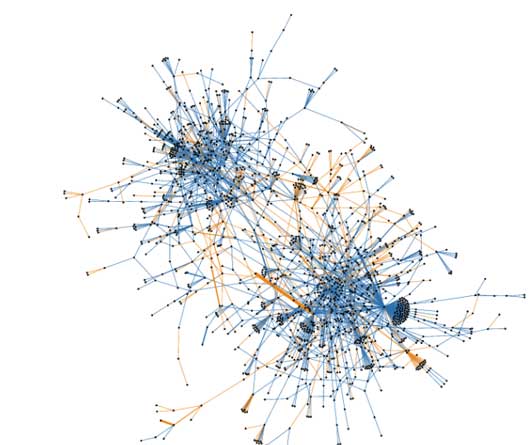September 30, 2010, 06:05 PM ET
Separating the Truth From the Truthy

An Indiana University web project is separating the truth from the "truthy" in political Tweets online.
The project—named "Truthy," after Stephen Colbert's descriptor for misinformation dressed up as fact—mines Twitter to analyze patterns in political discussions and makes the information available online. The software allows visitors to take a closer look at Twitter trends to spot data manipulation by tech-savvy special-interest groups.
"We're trying to study how information propagates online through social networks, blogging, and social media," said Filippo Menczer, associate professor of informatics and computer science at Indiana, who is leading the research. Truthy, he said, attempts to answer the question, "Can we put together our understanding of complex social networks and crowdsourcing to automatically detect the spread of misinformation?"
Through the site's database of Twitter memes—ideas passed from user to user by retweets or mentions, often signified with hashtags like #TeaParty or usernames like@LadyGaga—visitors can track how often a meme is mentioned by how many unique users as well as the volume of tweets over time. Truthy also checks tweets against a list of words and word clusters compiled by psychologists to determine a tweet's mood. Truthy can tell, for example, whether users are hostile or supportive of #GOP at any given moment.
Visitors are also asked to identify memes that appear to have been tampered with by flagging them as "truthy." This crowdsourcing tool will allow users to see where misinformation is being spread and will eventually help researchers develop algorithms to automatically identify Twitter abuse by identifying "truthy" behavior. "We're interested to see if we can get reliable data from crowdsourcing," Mr. Menczer said.
The site has also introduced a new way to visualize memes as they emerge and grow. Maps of twitter memes—like #GOP, pictured above—show interactions between individual users (represented by black dots) as they connect via retweets (the blue lines) and @replies (the orange lines). As various user clusters spring up around a topic, their activities are mapped by the Truthy software. In the #GOP example, Mr. Menczer said two distinct clusters—conservative and liberal—have emerged with each clusters' users parroting members of their group with retweets and talking about members of the other cluster through mentions in @replies. That's why you see two dark blue clusters connected by a matrix of orange lines.
Truthy was inspired by a study on Twitter bombs—floods of messages by a small group of users to manipulate trending Twitter topics—done by a researcher team at Wellesley College earlier this year. Accoriding to researcher Pagiotis Takis Metaxas, a professor of computer science at Wellesley, the study looked at the tactics of a Conservative group that manipulated trending topics on Twitter on the day of a senatorial election in Massachusetts in January. The study found that the political group started nine Twitter accounts just days before the election and monitored Twitter users who were posting about the upcoming election. On election day, the group sent @replies with disparaging comments about the Democratic candidate and a link to the group's Web site to 60,000 users before they were shut down by Twitter administrators. The Twitter bomb not only spread misinformation about candidate Martha Coakley, but the tweet also appeared in Google search results since the search engine was displaying real-time messages online at the time. "As we were looking through the data, we suddenly realized that there was some pattern that was trying to influence Google," Mr. Metaxas said.
Although he does not believe the bomb had a major impact in the election outcome, Mr. Metaxas said the group's attempt to influence Twitter and Google search should make internet users more wary of what they read online. "People who are not very astute to the way these things work may get confused," he said. "We need to have very good critical thinking skills to survive."
While Mr. Menczer said the Truthy format is not yet set in stone, he hopes that the Web site will stop political groups from "abusing the system and spreading misinformation."
"Ideally," he said, "this will disincentivize the abuse."

No comments:
Post a Comment
Note: Only a member of this blog may post a comment.